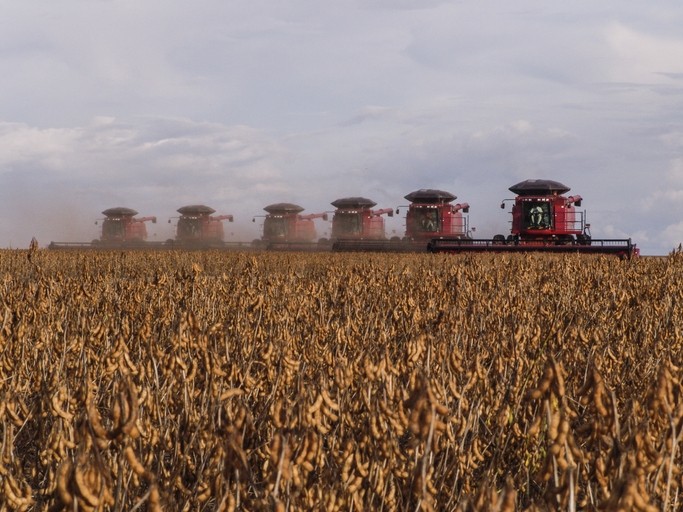Weather, trade present challenges for some Brazilian feed crops

The US Department of Agriculture (USDA) shared details regarding Brazil’s soybean production and trade in the feed ingredient in a recent Foreign Agricultural Service’s attaché’s report.
Overall, the area planted in soybeans in Brazil is not anticipated to drop for the 2018/19 market year (MY), said the attaché. However, the amount produced is forecast to drop to 115.5m metric tons.
“Dry and hot temperatures affected vast portions of key soybean growing regions, and as a result soybean yields are expected to drop across Brazil in 2018/19,” she said.
Yields in some areas are anticipated to fall to less than 3.2 metric tons a hectare.
Additionally, the export forecast for the 2018/19 marketing year fell 16% to 70m metric tons following the previous year’s 84m metric tons, she said.
Production challenges, increasing costs
Several of the main growing areas in Brazil have faced hotter-than-normal temperatures and little rain for the last several months, said the attaché.
The estimation from the soybean producers association is that most regions will see drops of 5% to 30%
“The drought-like conditions began in November in the south of the country in the second largest producing state of Parana, as well as in the southern states of Mato Grosso do Sul and Sao Paulo; from there, the same weather pattern spread further north into parts of Mato Grosso, Goias, Minas Gerais, and the northeast state of Bahia,” she added.
The influence of the dry conditions has been compounded by producers having a fast planting period for the 2018/19 crop, which benefited from early rain, she said.
“Producers were highly motivated to sow as early as possible considering the planting timeframe of the second, or safrinha, crop."
Soybean producers also are expected to face higher costs for inputs and feed crop transportation as premiums plateau, the attaché said.
Production costs were forecast to increase in soybean growing regions during 2018/19 based, in part, on higher fertilizer costs, she said.
“There is also significant uncertainty regarding freight rates, which affect the farm gate price that traders are willing to pay to producers."
A floor price for commercial freight rates was established to end a trucking strike, she said. However, some transportation contracts are still being made at market rates as the risk of fines may outweigh the government-set freight rates.
“However, the significant legal uncertainty surrounding future freight costs almost certainly weighs on current and future soybean prices,” the attaché said. “The new administration, inaugurated January 1, has indicated that the freight rates will remain in place at least through July. At this point, it is difficult to predict how this policy will evolve.”
China, trade and feed ingredient exports
Total soybean exports in the 2017/18 MY – which ran February 2018 through January 2019 – were increased to 84m metric tons based on demand from China, the attaché said. Exports in November topped 5m metric tons, setting a new record for the month.
“Strong export sales are driven by Chinese demand, amid US-China trade tensions,” she said. “In December 2018, some 97% of Brazil’s total soybean exports were destined for China, surpassing the record share of 96% of total soybean exports destined for China in November, 94% in October, and 91% [in] September of 2018.”
“Just 67% of Brazil’s exported soybeans were destined for China, on average, in that same timeframe during the last four years."
However, the temporary truce between the US and China and related sales of US soybeans to China has lowered soybean futures’ prices in Brazil – by up to 30%, said the attaché.
“In April 2018, China imposed a 25% duty on US soybeans, spurring its buyers to source a greater volume of soybeans from Brazil,” she said. “This underpinned the premiums commanded by Brazilian soybeans in the second half of 2018.”
The export forecast for 2018/19 MY fell to 70m metric tons, a drop from the past period’s exports estimated at 84m metric tons, she said.
“The revised forecast is based on reduced harvest volume, and virtually non-existent stock carryover from the 2017/18 MY,” said the attaché. “As of mid-January 2019, market analysts reported that Brazilian producers had sold 99% of their 2017/18 harvest, compared to 94% of the previous harvest sold at this time last year.”
The current pace of sales is in line with those set in 2017/18, but below historical averages, she said.
“While the pace of sales indicates about average market activity for this time of the year, there are increasing reports that futures trades have slowed significantly recently as producers are in a wait-and-see mode, hoping to see better prices as a result of lower supplies."
Soy crush in 2018/19 is anticipated to be about 43m metric tons, she said. Soymeal exports are forecast to fall to 16m metric tons during the marketing year based on improving harvests in the region and related competition on the international market.
“With increased regional competition, product prices may see some downward pressure, squeezing already tight margins for Brazilian processors,” she said. “Meanwhile, domestic demand for soymeal product is expected to rise just slightly to 18.2m [metric tons], up from 17.8m [metric tons] as domestic economic growth drives a slight increase in demand for meat and poultry products.”









